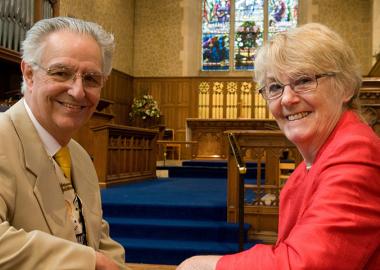We hear from groups about how they have managed to put on risk-assessed, COVID-secure performances for their audiences.
Putting on a COVID-secure performance: Norwich Chamber Music | Putting on a COVID-secure performance: Witney Music Society
Grayshott Concerts, based in Hampshire, is a promoter group specialising in presenting classical symphony concerts, concertos, oratorios, opera, and occasional drama. We put on four to five events a year (Jan-Dec), plus a members' only evening. Ticket prices are £32 – centre, and £28 – side aisles. Membership donations range from £25-£250 and some pay significantly more (160 members in 2020, previously 210). We can normally accommodate 337 and up to 375 when needing a smaller stage. Every event since starting in 2004 has ‘sold out’ at our regular venue, St Luke’s Church. We are a registered charity with six trustees. There are no employees but up to 35 ‘helpers’ who act as Stewards, or help with stage erection, ticketing, venue preparation, programme design etc.
What was your group’s initial reaction when lockdown was introduced in March?
We managed to complete our last pre-COVID event on 13 March, ten days before lockdown. We felt very lucky, but hoped it would all be over soon. We eventually ‘postponed’ our June event (Bruch violin concerto) until October and have now retained the soloist, but reduced the work size to baroque dimensions for a morphed event in October. We tried to keep our September and November events in place, but it soon became clear that, as one was operatic and the other choral, neither would take place until rules on singing changed. We have kept all our people informed throughout by regular e-newsletters and local news stories – plus a scattering of phone calls. We have also tried a lot of social media activities. Our members (‘Friends of Grayshott Concerts’) are entitled to priority booking and can therefore book early, but don’t have to pay until just before the event. This encourages early booking (to get the best seats), which dictates how we handle publicity. This meant that there were no ticket monies to refund.
Our church venue had arbitrarily decided on a ceiling of 80 for their own activities, but readily agreed to 90 when we shared risk assessments. But would the public come at all? We set about phoning key members of our regular audience who proved more than eager to come, with very few exceptions
When did you start to look ahead to future concerts, and what were your considerations?
As the lockdown began to show results (early May), our local authority (East Hants District Council) offered grants to local COVID-related activities. We realised how much our local, young-at-heart, elderly audiences were missing events (they told us so when we bumped into them in the local shops!), so we began to plan a series of events starting in October. ‘It’ll all be over by then!’ we thought. So we put together a programme of events to attract the audiences to come out of lockdown. We received a substantial grant which galvanised us into action and we began to develop our plan in earnest.
The main problem was: ‘What do the government guidelines really mean? Is it 2m separation or is 1m sufficient?' We decided on 2m to be sure and played with different layouts to try and work out how to get the highest capacity, and it was best (104) if everyone came in pairs. But of course they don’t! We ended up with a workable layout of about 85 people per event.
Our church venue had arbitrarily decided on a ceiling of 80 for their own activities, but readily agreed to 90 when we shared risk assessments. But would the public come at all? We set about phoning key members of our regular audience who proved more than eager to come, with very few exceptions.

London Mozart Players perform during the socially distanced concert
What other details did you need to consider in planning a COVID-secure performance?
By late August it was clear that no performances were assured until October, so we set dates (with performers’ agreement) for 7 October, 23 October and 27 November. Our first priority was risk assessments, which were handled jointly by our events director and managing director, using a number of inputs, templates, advice from experts, and discussions with our venue.
We also implemented the following measures:
- All bookings are in advance (no tickets available at the door), so we always have contact details of who is coming.
- We also require details of seating arrangements (eg 4 or 2+2) so we can allocate seats in advance, and programmes must be ordered and paid for when booking (and placed on seats), to avoid handling cash on the day.
- We required those booking to agree to comply with all our COVID requirements: face coverings; hand sanitisation; 2m social distancing; staying in allocated seats!
- We decided to change the layout of seating in part of the church to enable easier contactless access to rows – otherwise few changes to the seating were necessary.
- We shortened each half to 35 minutes (from 45), halved the interval to 15 minutes, and invited patrons to bring their own refreshments, abolishing the bar.
- Ventilation is not thought to be a big problem, because ours is a lofty draught-ridden venue – and we keep doors open except during the actual performance.
- We made the first concert free (as a dry run), but kept usual pricing policies for the others.
- We are able to maintain our usual high standards when looking after performers, with the exception that we asked performers to make their own tea (normally provided for them by one of our team).
- We took every opportunity in all our communications (and on tickets and venue posters) to stress face coverings, hand sanitisation and 2m social distancing.
- We provided extra stewards to police all this on the night(s).
We opened booking online for the first event in early Sep and were delighted when it sold out in 40 minutes. We immediately decided to stage all three events twice with the second performance the day after. Fortunately, all performers were available. We now have five fully sold-out performances averaging 85 seats each.

What did and didn’t work well at your COVID-secure performances?
We’ve only done two concerts so far (both sold out), but the reaction has been astonishing and so rewarding. Everything worked pretty well on the night(s), especially using extra stewards to police and explain rules.
Not so well?
- We controlled entry distancing OK at the start, but people bunched together noticeably on exit. One solution would be an aeroplane-style exit – row-by-row, using doors at the back and front, under strict instruction.
- A few people dropped their masks/coverings below their noses, so more monitoring is necessary.
- There was too much close mingling during the interval, so again better enforcement is necessary.
Costings are lower for artists (smaller works performed in order to get them on stage), but higher for website design (constant changes), cleaning, publicity (more emails, newsletters etc). Financing all this is totally absurd when you consider that, for each event:
- Capacity was reduced by 75% due to social distancing, so income was reduced to a quarter of the normal amount
- Artistic costs almost doubled (two performances instead of one to accommodate all who wanted to come)
- There were additional COVID costs (publicity, website, cleaning, sanitisers, tapes, boards etc)
Fortunately we’re well placed financially and we’ll carry on putting on performances while resources are available. We’re enjoying every moment of providing top-quality classical music to audiences who love it just as much as we do.
We’ve only done two concerts so far (both sold out), but the reaction has been astonishing and so rewarding. Everything worked pretty well on the night(s), especially using extra stewards to police and explain rules
What top tips would you give to anyone planning a COVID-secure performance?
-
Go for it – don’t let COVID get you down as your audiences are crying out for music!
-
Don’t cut corners on planning and research. They will give you the confidence to achieve the impossible.
-
Get plenty of help at running the event. It’s all new and needs strong (but charming) policing.
We now realise that getting consistent audience bookings is not down to what we’re doing now, but what we’ve been doing regularly for the last 16 years, building trust and developing confidence in our organising abilities and, of course, marketing, marketing, and more marketing...
Our email and phone contacts with members made absolutely clear that live music was vitally important to them. So we felt it was essential to stage live events as soon as we could – whatever the cost – because that’s what we do! We used our reserves, because that’s what they’re for, and the pay-off was continued loyalty and support from our audience.
Putting on a COVID-secure performance: Norwich Chamber Music
Putting on a COVID-secure performance: Witney Music Society
We hope you find this Making Music resource useful. If you have any comments or suggestions about the guidance please contact us. Whilst every effort is made to ensure that the content of this guidance is accurate and up to date, Making Music do not warrant, nor accept any liability or responsibility for the completeness or accuracy of the content, or for any loss which may arise from reliance on the information contained in it.










